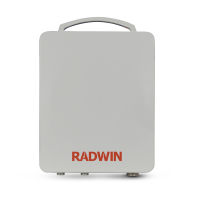Appendix B. About Antennas
B.1 Scope of this Appendix
This appendix provides some basic informaon and consideraons regarding antennas and what you need
to take into account when conguring antenna parameters.
B.2 Antenna Issues
The choice of Tx Power, antenna gain and cable loss (between the radio and the antenna) determines the
EIRP and is aected by such consideraons as radio limitaons and regulatory restricons.
Before proceeding to antenna installaon details, the following background informaon should be
considered:
B.3 About Single and Dual Antennas
Each RADWIN radio is actually made of two radio transceivers (radios). The radios make use of algorithms
that ulize both Spaal Mulplexing (also called MIMO) and Diversity resulng in enhanced capacity, range
and link availability. The number of antennas (i.e. radios) used is determined by user conguraon and by
automac system decisions, explained below.
B.3.1 Dual Antennas at the HBS and an SU
When using dual antennas at both sites (single bipolar antenna or two mo‐unipolar antennas) you can
choose between Spaal Mulplexing Mode and Diversity Mode.
Under this mode, the system doubles the link capacity. At the same me, it keeps the same rate and
modulaon per radio as was used with single antenna, thus increasing capacity, range and availability.
For example with a dual antenna RADWIN 5000 can transmit at modulaon of 64QAM and
FEC of 5/6 and get an air rate of 130 Mbps, compared to 65 Mbps with single antenna.
To work in this mode, each antenna port must be connected to an antenna, the RSS level in both receivers
should be balanced and a minimal separaon between the antennas must be maintained. (For example, by
using dual polarizaon antennas a cross polarizaon separaon is aained).
Upon selecng Antenna Type as Dual, RADWIN 5000 automacally selects this mode and doubles the air
rates.
RADWIN Manager indicates a case of unbalanced RSS between the two antennas in the HBS panels.
Diversity Mode uses two antennas to improve the quality and reliability of the link. Oen, there is not a
clear line‐of‐sight (LOS) between transmier and receiver. Instead the signal is reected along mulple
paths before nally being received.

